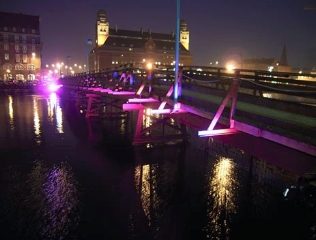


| URL: | http://netzspannung.org/database/386362/de |
| Last update: | 23.03.2007 |
| Date of print: |
 |
Kurzdarstellung
Kurzbeschreibung
Binary Bridge is a place-specific interactive light installation conceived and realized by four students from the Interaction Design Master Program at the School of Arts & Communication at Malmö University. The installation was officially opened on March 15th 2007 and will be running for one month.
KünstlerInnen / AutorInnen
- Helge Fischer, student, Malmö University, K3
- Mey Lean Kronemann, student, Malmö University, K3
- Freddie Eksteen, student, Malmö University, K3
- Neda Hajmomeni, student, Malmö University, K3
Entstehung
Schweden, 2006-2007
Partner / Sponsoren
Malmö University, City of Malmö, Malmö Citytunneln
Eingabe des Beitrags
Helge Fischer, 23.03.2007
Kategorie
- künstlerische Arbeit
Schlagworte
- Themen:
- öffentlicher Raum
- Formate:
- Installation |
- interaktiv
Ergänzungen zur Schlagwortliste
- light design |
- place-specific
Inhalt
Inhaltliche Beschreibung
Twelve motion sensors react when people are crossing the bridge which connects the city´s central station with the university. Each sensor represents a digit number in binary code, giving a "1" when somebody is passing by the sensor and giving a "0" otherwise. This twelve digits number is directly mapped to a (RGB-)colour in which the bridge is illuminated from underneath. As people cross the bridge the binary number and thereby the colour constantly change. All people´s movements affect the colour ranging from no light when nobody is passing by to bright white light when the bridge is crowded.
The bridge is located in the old harbour of Malmö which is after the downfall of the shipping industry now mainly occupied by new media agencies, service industry and the Malmö University. The installation refers to the rapid change of produced and transported and traded goods in this area which were in recent times physical artefacts and products and that are now mainly replaced by digital products, services and information. Instead of freight people nowadays transport intellectual property from the area (from the University and the agencies) to the city and country. The bridge serves as a major conductor and the installation tries to visualize the information exchange by treating the passing people as bits and thereby creating a data-stream.
Technik
Technische Beschreibung
Twelve motion sensors are mounted at intervals of 7 metres across the bridge. A microcontroller processes their signals into the DMX-protocol which is sent to the dimmers that control the lights (six 1000W spotlights). As microcontroller we used the one which comes on the arduino-board (an open-source physical computing platform) together with a DMX transmitting shield.
Hardware / Software
six 1000W lights, arduino board, motion sensors
|
|
| » http://binarybridge.k3.mah.se |
|
|